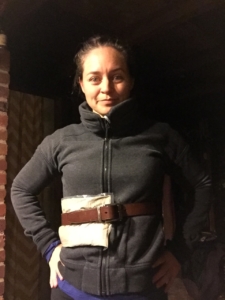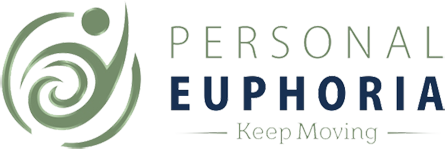
Here I am gently using a belt to tie an icepack around my ribs so that I can go about my day while icing.
One of my most popular blogs is my story of getting costochondritis. I get question from all over the world about whether I know experts in the field or what I did to heal my costochondritis. As a lover of movement I’m ashamed to say I don’t have a definitive answer for either. I don’t know costochondiritis experts around the world to refer people to. And I can make some guesses about what helped me, but I can’t say for sure. I don’t have a ‘do these ten things in this order and your problem will be solved.’ The solution for me was more complicated than that. I used a lot of experimentation and caution. But I do believe that when your body is in pain, sometimes you need to experiment with safe options. Below you will find the possible costochondritis causes and possible solutions.
What causes costochondritis (an unbelievable pain in the ribs caused by inflamed cartilage) we don’t know. Some possibilities are repeated trauma, overuse of the arms (this exacerbated mine) or viral respiratory infections. The latter definitely resulted in mine. I had a terrible cough for six weeks. A cough that woke me up in the night with larynx spasms. A cough that woke my neighbors. By the end of six weeks I swore I’d broken a rib coughing. I didn’t. I had costochondritis.
Here’s what helped me, but you should always consult a doctor because every one of us is different and all our bodies are different.
· Anti-inflammatories (but if you are doing this for a long time you should talk to your doctor). I tried to use some natural ones like turmeric, but it needs other ingredients to work.
· Icing the area daily.
· Trying to immobilize my ribs for three weeks (almost impossible). In addition to trying not to move my ribs, I wouldn’t use my right arm to open the car or the refrigerator. Moving my right arm seemed to aggravate everything so I used it as little as possible. I did not exercise except walking.
· Chiropractic care made a huge different. I’d never been to a chiropractor and was nervous, but I remember being in awe when I felt relief for the first time. I was actually able to use my right arm. The relief lasted hours. And I went twice a week for six week. The more I went, the more the relief lasted. I’d be cautious with this option and only go to someone you know is good and be clear about anything you are uncomfortable having them do. It’s your body. Say “No” if you want to.
· I also made time for weekly 30-mintue massages around my ribs and shoulder girdle with a trained massage therapist who is also an occupational therapist and works with injuries. I swear by this. It wasn’t a treat (well, it was), but I don’t think I would have improved as fast without it. And since I couldn’t do my job without improving, I viewed massage as a form of physical therapy. I’d leave my clothes on and she would rub the affected area and do gentle movements with my limbs.
· Minimal arm exercises for about a year. For a solid year if I did push-ups, any movement that was arm heavy, or had my arms overhead I’d have a little setback. After six months arm movement didn’t cause pain as bad as my initial injury, but I sensed I could easily wind back up at the beginning. I’d get this feel of strain and weakness around my ribs. It was hard to keep myself from doing arm work, but a setback wasn’t worth it. I’m still cautious about arm work to this day, but I seem to be able to do most things. I’m diligent with myself about form and stop when I feel myself cheating or losing stability. I use lighter weights and do less reps than I used to. It’s just not worth it.
· For at least six months, I only did limited spinal flexion (think a rounding forward of the spine as in a crunch or the full roll up). The only time I did this movement was when demonstrating in a class I teach. I did no flexion in my personal routines. Now I can do all that with no problem at all. But remember there were three weeks when I didn’t even demonstrate in class. For three weeks I moved my ribs and little as possible. Basically, I breathed and rolled out of bed each morning.
· I still did what I could do in Pilates. I went to my regular weekly private (sacred time for me). Sometimes I felt lame for how little I could do, but I did it. And I felt better every time I left that class.
· I self-braced for every sneeze and cough. I spent over a year terrified of coughing. And months terrified of sneezing. I don’t remember exactly when that fear went away, but the loss of fear is a sign of improvement.
· Finally, my final fix came in a yoga class. This is the tricky part to my solution. While I think everything I was doing was a part of my resolution, and I do not think this would have helped without everything that came before, I attended a very challenging yoga class. At one point the teacher adjusted my position and I remember thinking I would suffer for the adjustment. I thought it could create a setback. I thought it was too much for me. But when I came out of the pose any lingering pain disappeared. There was immediate relief like my first visit to the chiropractor. I cannot preface enough how much I don’t think this would have helped if I hadn’t done everything I’d done for a year leading up to this moment. And I don’t know how that moment could be recreated for anyone. I think you can heal without it.
My doctor only suggested rest. And that didn’t leave me much to work with. Since I work in movement stillness simply wasn’t always an option. Besides, if you are breathing you can’t really rest your ribs. I really benefited from a variety of practitioners. Massage is key. Ice is key. Figuring out what seems to aggravate you is key. And stop whatever that is for a while. Cartilage can take a long time to heal, but in my experience it can improve.
Keep Reading!
Here is the first post about Costo and how I got it.
Want more TMI about me? Read my blog about SIBO (small intestinal bacterial overgrowth).
Quirks when sharing a hotel room with family and friends.
Keep in Touch
Order Your Copy of Keep Moving Today!
Subscribe to the Keep Moving Blog
Like the Personal Euphoria Facebook page
Find us on Twitter
Follow me on Instagram
Subscribe to my YouTube Channel

[…] (an inflammation of the soft tissue around your ribcage). At first push-ups seemed to inflame the chosto. I’m still nervous about doing push-ups even though I did them for thirty-four years without […]
Chostochondritis/ or is it Stenalis Syndrome , Whatever , it definitely developed ,almost immediately after a bout of viral pneumonia. No definitive diagnosis, but I am over it !!! Pain ,is insufferable at times . NO Dr can definitively diagnose ,nor offer help . Can you suggest PLEASE judiI (. judisewell13@gmail.com.au. )
Hi Judy,
Chosto was incredibly painful and it was hard to not know it was going to go away. There is hope because I have no pain now (knock on wood). I can’t give a specific thing that worked. I think multiple things helped me–a good chiropractor who was gentle, working with Pilates, icing, not doing anything that caused pain for a few weeks. And then I was very cautious about anything I thought would aggravate it for at least a year. Also a massage therapist who is also an Occupational Therapist so she understood the body. I went for 30-minute sessions that gently focused on my ribs each week for maybe six weeks and then down to every other week for another month or so. Same schedule for the chiropractor. If you think those are helping you’d have to base it on how you feel.
Thanks for sharing such wonderful knowledge! Herbal Treatment for Costochondritis reduces pain and inflammation of the affected area.